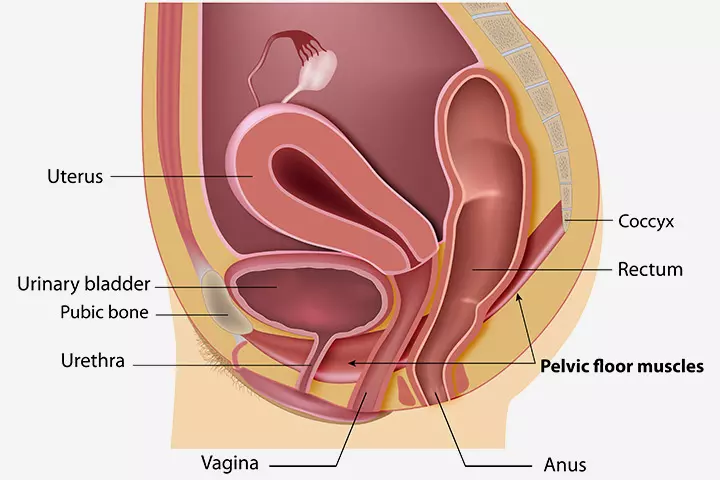

Image: Shutterstock
Kegel exercises are named after an American gynecologist, Dr. Arnold Kegel, who first invented them around 1948. He suggests that regular, non-surgical, targeted Kegel ball exercises during pregnancy help bolster your pelvic floor muscles and assist in uncomplicated labor and childbirth. They can also help with urinary incontinence and help you achieve bladder control, both of which are frequent problems during and after pregnancy (1).
Read on to know more about kegel exercises, including their benefits, how they strengthen the pelvic floor, how to prepare for them, when you should do them, and some of the best kegel exercises to attempt while pregnant.
What Are Kegel Exercises?
Kegel or pelvic floor exercises, also known as Kegels, are simple clench and release exercises which strengthen pelvic floor muscles. The pelvis is the region between the hips, which holds the uterus, bladder, small intestine, and rectum. The series of tissues and muscles that form a hammock or a sling at the bottom of your pelvis is called the pelvic floor. This hammock holds these organs in place and therefore controls the urine flow as well as the contraction of anal sphincter and vagina. (2)
Image: Shutterstock
Why Should You Do Kegel Exercises?
Various things can weaken pelvic floor muscles (PFM), especially pregnancy and delivery that stress these muscles out. Also, chronic constipation, obesity, advanced age, and certain surgical procedures take a toll on pelvic muscles.
A weak pelvic floor can cause the pelvic muscles to bulge and descend into the vagina, and this condition is called pelvic organ prolapse (3). It leads to pelvic pressure and leakage of feces and urine. Kegel exercises can help significantly to avoid this situation.
How Do Kegels Strengthen The Pelvic Floor?
Kegel exercises improve the strength of pelvic floor muscles, supporting the functioning of the uterus, bladder, rectum, and intestines.
The medical name of PFM is Pelvic Diaphragm, and the main part is the levator ani. It refers to a group of muscles namely puborectalis, pubococcygeus, and iliococcygeus. These work together and control urination and sexual excitement. They cover the urethra, and therefore when Kegels improve their strength, you will have better control over urination.
Benefits Of Kegel Exercises During Pregnancy
Kegel exercises will help to make you feel comfortable as you approach your due date.
- As the uterus expands, it strains the muscles and ligaments that enclose it. If you have weak muscles, you may experience urine leakage, also referred to as Urinary Incontinence (UI), especially in the third trimester. Activities like sneezing, coughing, laughing, or jogging can lead to occasional leakage of urine. Performing Kegels can, therefore, lessen or prevent this condition (4).
- Strong pelvic floor muscles ease the delivery process, especially during the pushing stage. Kegel exercises help you understand how to contract and relax your muscles in preparation for childbirth. Relaxing your muscles helps the baby move out of the womb smoothly, reducing any chances of tear or injury in the intimate area. Research studies state that more than 20% of pregnant women experience some tear or injury in the pelvic floor disorder during childbirth (5). This happens as the muscles overstretch to make room for delivery
- Research also states that women who indulge in pelvic floor exercises are known to experience shorter active phases of labor than those who do not exercise (6).
- Performing Kegel exercises while you are pregnant will improve the blood circulation in the genitals which will speed up the recovery of hemorrhoids (swollen or group of veins in the region of the anus) and episiotomies (surgical cut made at the opening of the vagina during childbirth) after childbirth.
- These exercises also tone up your vaginal muscles, thereby boosting your sex drive.
How Can You Find Your Kegel Or Pelvic Floor Muscles?
You can identify the right muscles by holding your urine mid stream. The muscles you use while doing so are the ones you have to contract while doing a kegel. But once you locate them, do not develop a habit of interrupting the urine flow to do kegel exercises as it can lead to urinary tract infections, urinary continence, and other conditions.
If you are still unsure about knowing which muscles to work on, wash your hands with soap and insert one finger into your vagina. The pressure you feel around your finger when you try to contract the pelvic muscles is the area. You can feel the tightening of your muscles and the pelvic floor moving up. Try relaxing and you could feel the pelvic floor moving down again. You can also ask your partner to feel those muscles when you are making love.
Another way of finding them is to insert your finger into the vagina and press the muscles firmly.
You can ask your gynecologist to train you to find the right muscles. She may suggest you use a vaginal cone, an object that can be inserted into your vagina, to keep the pelvic floor muscles in place.
Biofeedback training is another useful technique your doctor may use. She will either insert a small probe into your vagina or keep adhesive electrodes around the vagina or anus. You will then be asked to perform kegel exercises. The probe will be connected to a monitor, which shows whether you have properly contracted your muscles and the duration for which you were holding the contraction (7).
How To Prepare For Kegels?
- You should not perform Kegels when your bladder is partially or completely full as there could be some urine leakage or pain. Make sure your bladder is empty before you start to exercise.
- The Kegels should focus only on pelvic muscles and you should not flex other muscles like those of abdomen, thighs, or buttocks.
- Make sure you continue breathing normally, and don’t hold your breath while doing Kegels. It improves concentration and efficiency of the movements and also helps you relax.
- You can place one hand on your tummy to relax your pelvic muscles and tummy.
How To Do Kegel Exercise During Pregnancy?
Once you find the pelvic floor muscles and are well-prepared, you should:
- Contract (squeeze) and pull in the muscles around the back passage and vagina at the same time. You should feel that sense of lift every time you contract your PFM.
- Hold them tight and strong until you count to five.
- Relax the muscles gradually. You should get that feeling of ‘letting them go’.
- Rest for about ten seconds before you start another Kegel.
- Start with three to four Kegels in a row a few times a day.
- You can slowly increase the number of seconds for squeezes each week.
- Once you reach about ten seconds, slowly increase the number by one each week until you reach ten Kegels in a row for three times in a day.
- You can go up to three times of 20 Kegels every day.
Do not worry if you are not close to the goal when you begin. Pelvic muscles are like any other muscles in your body. They will become stronger only with time, consistency and mindful work.
Beware: If you sense any pain in your back or abdomen after doing a Kegel set, it is a sign of you not doing them properly.
When Should You Do Kegels?
It is never too late to begin Kegels. The earlier you start, the greater the benefits throughout pregnancy and even after it.
Make them a part of your everyday routine. You can do them while sitting, standing, or lying down. It does not matter when and where you perform them. You can do them:
- Soon after you wake up in the morning or
- Before going to bed.
You can also do these exercises in the waiting room at the doctor’s clinic, while waiting at pharmacies, when you have stopped at the red signal light, while watching television, and more.
If you find it hard to remember to practise your kegels, identifying a ‘trigger object’ can be helpful. For instance, whenever you see the fridge throughout the day you may remember to do a set, or when you sit down in front of the television, whenever a certain ad comes on, or everytime you fold the washing.
You can restart the Kegel routine after delivery to promote healing, improve muscle tone and stimulate circulation. They help your muscles get back in shape. Do not be alarmed if you cannot sense the ‘squeeze and lift’ right away. It is because the perineum remains numb after delivery, but it gets to normal gradually in a couple of weeks.
How Long Should You Continue Doing Kegels?
You could continue to do your Kegels right throughout your life, as they help in maintaining your pelvic strength and will help avoid issues such as urine incontinence, which comes with age. Your doctor would likely suggest the same.
Active Kegel exercises also protect you from pelvic organ prolapse, which is a common issue as you age. Prolapse causes urine incontinence, lower back pain, a sense of heaviness in the pelvic region, as well as discomfort during intercourse (8).
When Can You See The Results?
Most women can notice results within four to eight weeks of regular Kegels. For some others, however, it may take many months to see improvement in the pelvic floor.
Best Kegel Or Pelvic Floor Exercises That Work
Image: Shutterstock
1. Floor Lifts:
It is an effective pelvic floor exercise that strengthens the muscles. The lower back and arms are involved in this exercise, being toned and strengthened as well.
How To
- Lie on your back with knees bent and feet flat on the surface.
- Inhale while engaging your pelvic floor and lifting your hips
- Continue breathing and hold for about ten seconds.
- Lower the hips and release your pelvic floor. Repeat ten more times.
2. Vertical Thighs Using A Ball Or Towel:
This exercise lifts the pelvic floor muscles. When you combine this exercise with floor lifts, you will be working these muscles from all the angles.
How To
- Stand against a support, like a wall or a chair, at an arm’s length by keeping your hands on the support.
- Keep your feet close, parallel with heels touching each other and place a rolled up towel or a medium sized ball in between your inner thighs.
- Lift heels off the floor by bending your knees slightly. Hold this position and try to squeeze the towel or the ball at different tempos. First, squeeze quickly, 25 times, followed by a second’s rest and then squeeze again slowly for another 25 times.
- To finish, lower the hips down to your heels, and move up and down for about ten times.
Ways To Make Kegels Fun
You can make Kegels fun this way:
- You can combine them with sex which will enhance the pleasure for both you and your partner. Your partner can also check whether you have contracted your muscles properly.
- You can try a smartphone app. It can track your exercise routine, send you reminders and provide musical routines for workouts.
- Vaginal exercisers are another great way. They help in keeping your muscles in place. Some devices also provide electrical stimulation to your pelvic muscles. They could, however, be risky as bacteria or other microbes could affect your intimate area. You should check with your gynecologist before trying them.
Frequently Asked Questions
1. Can I overdo Kegels?
You should breathe normally when doing Kegels so as not to strain yourself. Also, do not perform them while urinating, as this can strain the pelvic floor muscles (9).
2. How soon after birth can I start Kegels?
You should wait a day or two after the childbirth to start doing gentle pelvic floor exercises and observe if you feel any pain. You can then gradually proceed to an increased number of Kegels (10).
Performing Kegel ball exercises can help strengthen your pelvic floor muscles, which may be weakened by pregnancy. Further, these exercises can help prevent urinary incontinence, improve genital blood flow, and ease delivery. Emptying your bladder before the routine, focusing on flexing only the pelvic muscles, and breathing normally are some precautions to keep in mind while doing Kegel exercises during pregnancy. However, consult your doctor if you don’t notice any improvement in your pelvic floor muscles after three to four months of regular exercise.
References
- Andrea Marques, et al., (2010), The status of pelvic floor muscle training for women
https://www.ncbi.nlm.nih.gov/pmc/articles/PMC2997838/ - Pelvic floor muscles.
https://www.continence.org.au/about-continence/continence-health/pelvic-floor - Pelvic Organ Prolapse (POP).
https://www.fda.gov/medical-devices/urogynecologic-surgical-mesh-implants/pelvic-organ-prolapse-pop - Kegel exercises – self-care.
https://medlineplus.gov/ency/patientinstructions/000141.htm - Jennifer L. Hallock et al. (2017) The epidemiology of pelvic floor disorders and childbirth: an update
https://www.ncbi.nlm.nih.gov/pmc/articles/PMC4757815/ - Kjell Å Salvesen and Siv Mørkved (2004) Randomised controlled trial of pelvic floor muscle training during pregnancy.
https://www.ncbi.nlm.nih.gov/pmc/articles/PMC509343/ - Pelvic floor muscle training exercises.
https://medlineplus.gov/ency/article/003975.htm - Pelvic organ prolapse
https://www.nhs.uk/conditions/pelvic-organ-prolapse/ - Exercise during pregnancy
https://healthy.kaiserpermanente.org/health-wellness/maternity - Safe return to exercise after pregnancy
https://www.pregnancybirthbaby.org.au/safe-return-to-exercise-after-pregnancy
Community Experiences
Join the conversation and become a part of our nurturing community! Share your stories, experiences, and insights to connect with fellow parents.
Read full bio of Sarah Pearce
Read full bio of Rebecca Malachi

















